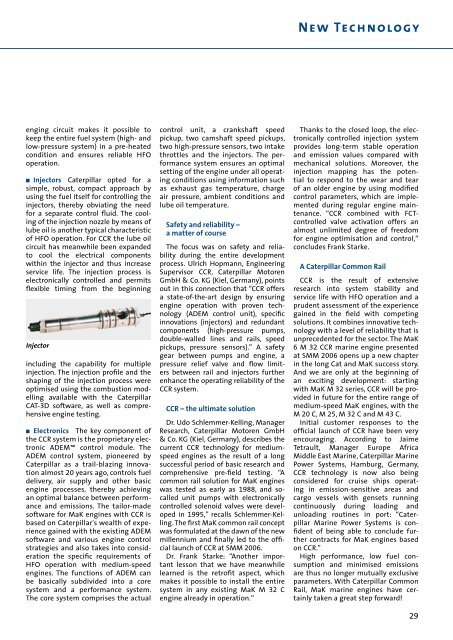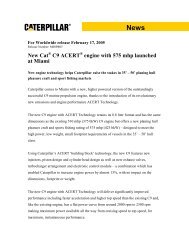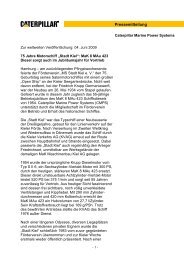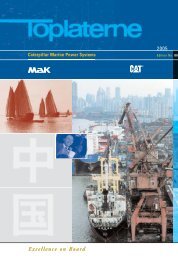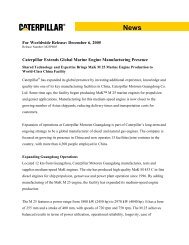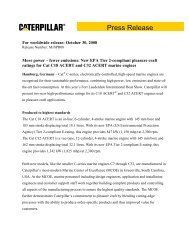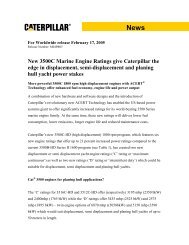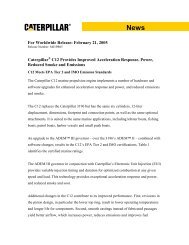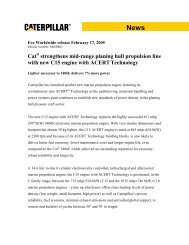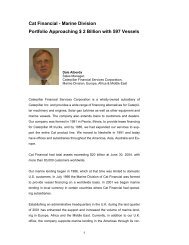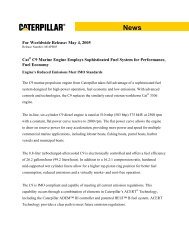Caterpillar Marine - Marine Engines Caterpillar
Caterpillar Marine - Marine Engines Caterpillar
Caterpillar Marine - Marine Engines Caterpillar
Create successful ePaper yourself
Turn your PDF publications into a flip-book with our unique Google optimized e-Paper software.
enging circuit makes it possible to<br />
keep the entire fuel system (high- and<br />
low-pressure system) in a pre-heated<br />
condition and ensures reliable HFO<br />
operation.<br />
n Injectors <strong>Caterpillar</strong> opted for a<br />
simple, robust, compact approach by<br />
using the fuel itself for controlling the<br />
injectors, thereby obviating the need<br />
for a separate control fluid. The cooling<br />
of the injection nozzle by means of<br />
lube oil is another typical characteristic<br />
of HFO operation. For CCR the lube oil<br />
circuit has meanwhile been expanded<br />
to cool the electrical components<br />
within the injector and thus increase<br />
service life. The injection process is<br />
electronically controlled and permits<br />
flexible timing from the beginning<br />
Injector<br />
including the capability for multiple<br />
injection. The injection profile and the<br />
shaping of the injection process were<br />
optimised using the combustion modelling<br />
available with the <strong>Caterpillar</strong><br />
CAT-3D software, as well as comprehensive<br />
engine testing.<br />
n Electronics The key component of<br />
the CCR system is the proprietary electronic<br />
ADEM control module. The<br />
ADEM control system, pioneered by<br />
<strong>Caterpillar</strong> as a trail-blazing innovation<br />
almost 20 years ago, controls fuel<br />
delivery, air supply and other basic<br />
engine processes, thereby achieving<br />
an optimal balance between performance<br />
and emissions. The tailor-made<br />
software for MaK engines with CCR is<br />
based on <strong>Caterpillar</strong>'s wealth of experience<br />
gained with the existing ADEM<br />
software and various engine control<br />
strategies and also takes into consideration<br />
the specific requirements of<br />
HFO operation with medium-speed<br />
engines. The functions of ADEM can<br />
be basically subdivided into a core<br />
system and a performance system.<br />
The core system comprises the actual<br />
control unit, a crankshaft speed<br />
pickup, two camshaft speed pickups,<br />
two high-pressure sensors, two intake<br />
throttles and the injectors. The performance<br />
system ensures an optimal<br />
setting of the engine under all operating<br />
conditions using information such<br />
as exhaust gas temperature, charge<br />
air pressure, ambient conditions and<br />
lube oil temperature.<br />
Safety and reliability –<br />
a matter of course<br />
The focus was on safety and reliability<br />
during the entire development<br />
process. Ulrich Hopmann, Engineering<br />
Supervisor CCR, <strong>Caterpillar</strong> Motoren<br />
GmbH & Co. KG (Kiel, Germany), points<br />
out in this connection that “CCR offers<br />
a state-of-the-art design by ensuring<br />
engine operation with proven technology<br />
(ADEM control unit), specific<br />
innovations (injectors) and redundant<br />
components (high-pressure pumps,<br />
double-walled lines and rails, speed<br />
pickups, pressure sensors).” A safety<br />
gear between pumps and engine, a<br />
pressure relief valve and flow limiters<br />
between rail and injectors further<br />
enhance the operating reliability of the<br />
CCR system.<br />
CCR – the ultimate solution<br />
Dr. Udo Schlemmer-Kelling, Manager<br />
Research, <strong>Caterpillar</strong> Motoren GmbH<br />
& Co. KG (Kiel, Germany), describes the<br />
current CCR technology for mediumspeed<br />
engines as the result of a long<br />
successful period of basic research and<br />
comprehensive pre-field testing. “A<br />
common rail solution for MaK engines<br />
was tested as early as 1988, and socalled<br />
unit pumps with electronically<br />
controlled solenoid valves were developed<br />
in 1995,” recalls Schlemmer-Kelling.<br />
The first MaK common rail concept<br />
was formulated at the dawn of the new<br />
millennium and finally led to the official<br />
launch of CCR at SMM 2006.<br />
Dr. Frank Starke: “Another important<br />
lesson that we have meanwhile<br />
learned is the retrofit aspect, which<br />
makes it possible to install the entire<br />
system in any existing MaK M 32 C<br />
engine already in operation.“<br />
New Technology<br />
Thanks to the closed loop, the electronically<br />
controlled injection system<br />
provides long-term stable operation<br />
and emission values compared with<br />
mechanical solutions. Moreover, the<br />
injection mapping has the potential<br />
to respond to the wear and tear<br />
of an older engine by using modified<br />
control parameters, which are implemented<br />
during regular engine maintenance.<br />
“CCR combined with FCTcontrolled<br />
valve activation offers an<br />
almost unlimited degree of freedom<br />
for engine optimisation and control,“<br />
concludes Frank Starke.<br />
A <strong>Caterpillar</strong> Common Rail<br />
CCR is the result of extensive<br />
research into system stability and<br />
service life with HFO operation and a<br />
prudent assessment of the experience<br />
gained in the field with competing<br />
solutions. It combines innovative technology<br />
with a level of reliability that is<br />
unprecedented for the sector. The MaK<br />
6 M 32 CCR marine engine presented<br />
at SMM 2006 opens up a new chapter<br />
in the long Cat and MaK success story.<br />
And we are only at the beginning of<br />
an exciting development: starting<br />
with MaK M 32 series, CCR will be provided<br />
in future for the entire range of<br />
medium-speed MaK engines, with the<br />
M 20 C, M 25, M 32 C and M 43 C.<br />
Initial customer responses to the<br />
official launch of CCR have been very<br />
encouraging. According to Jaime<br />
Tetrault, Manager Europe Africa<br />
Middle East <strong>Marine</strong>, <strong>Caterpillar</strong> <strong>Marine</strong><br />
Power Systems, Hamburg, Germany,<br />
CCR technology is now also being<br />
considered for cruise ships operating<br />
in emission-sensitive areas and<br />
cargo vessels with gensets running<br />
continuously during loading and<br />
unloading routines in port: “<strong>Caterpillar</strong><br />
<strong>Marine</strong> Power Systems is confident<br />
of being able to conclude further<br />
contracts for MaK engines based<br />
on CCR.”<br />
High performance, low fuel consumption<br />
and minimised emissions<br />
are thus no longer mutually exclusive<br />
parameters. With <strong>Caterpillar</strong> Common<br />
Rail, MaK marine engines have certainly<br />
taken a great step forward!<br />
29


